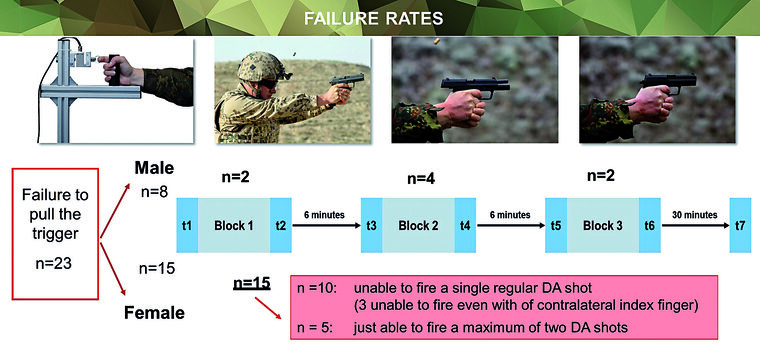Index finger strength and muscle fatigue during repeated pistol firing
Alexander Sievert a, Kai Nestler b, Ulrich Rohde a and Dieter Leyk a
a Bundeswehr Institute for Preventive Medicine, Andernach/Koblenz, Germany
b Bundeswehr Central Hospital Koblenz, Germany
Purpose
Repeated firing (e.g. in prolonged engagements) may entail muscle-fatigue in the index-finger, potentially decreasing the ability for repeated trigger-pulling, and ultimately the inability to pull the trigger due to reduced index-finger strength. Limited information is available on the relationship of finger-strength, muscle-fatigue and trigger pulling ability. Aim of this study was to analyze effects of repeated firing on maximal index-finger strength (MFS) during standardized exercises of close combat marksmanship training.
Methods
30 soldiers (15 male/15 female, dressed in field uniform, ballistic vest and helmet) fired 60 rounds with the standard issue sidearm (HK P8, mean trigger pull weight: double-action (DA): 58.8 N, single-action (SA): 26.3 N in three consecutive blocks with 6-minute intermissions between blocks. Blocks consisted of four standardized SA and DA exercises (5 shots each) at distances of 5 m or 10 m. Total exercise time (3 blocks + 2 breaks) was approximately 30 minutes. Maximal isometric finger strength (MFS) was measured immediately before (t1, t3, t5) and after (t2, t4, t6) each block and 30 minutes after shooting (t7).
Results
Repeated shooting significantly decreased MFS in male (145.8 ± 21.7 N (t1) to 112.7 ± 26.6 N (t6 ); p<.001) and female (88.2 ± 15.8 N (t1) to 67.3 ± 17.7 N (t6); p<.001) soldiers.
Mean MFS in males decreased after each block to 94.2 ± 10.5 % (t2), 83.8 ± 8.8 % (t4), and 76.7 ± 9.7 % (t6) while MFS in females decreased to 84.7 ± 12.1 % (t2), 77.0 ± 14.5 % (t4), and 75.9 ± 13.4 % (t6) respectively.
23 of 30 participants (8 male/15 female) were unable to fire all 60 shots of the training exercise. Higher initial MFS was positively correlated to lesser chance of failure (r=0.73: p<.001) and longer time to failure (r=0.82; p<.001). Participants with lower initial MFS reached critical strength levels earlier. 6-minute breaks between blocks were insufficient for significant recovery of MFS: MFS returned to approximately pre block 3 values (t5) 30 minutes post exercise ( t7).

23 of 30 participants (mainly female) were unable to fire all 60 shots of the exercise.
Conclusion and Operational Relevance
Repeated shooting at given trigger loads lead to muscle fatigue and ultimately failure to complete the exercise. Six minutes of rest were insufficient for MFS recovery. Besides adequate physical strength for locomotion and load- handling (leg extensors, arm flexors, trunk flexors/extensors and hand- grip), sufficient strength in the index-finger is a fundamental requirement for marksmanship and thus another integral prerequisite for military fitness.
Operational Relevance
Inadequate trigger weights may lead to individual inability to operate the standard sidearm in the operational setting during prolonged engagements.
For the authors
Alexander Sievert
Bundeswehr Institute for Preventive Medicine
Andernacher Str. 100, D-56070 Koblenz
E-Mail: alexandersievert@bundeswehr.org
Oral presentation at the ICSSP 2020 in Quebec, Canada (11 to 14 February 2020)